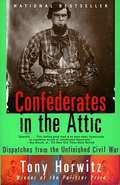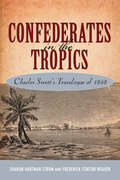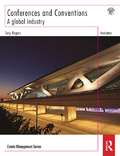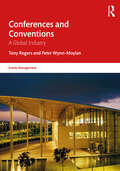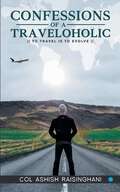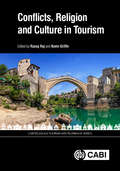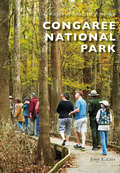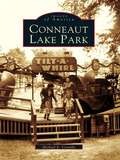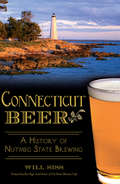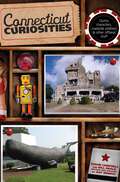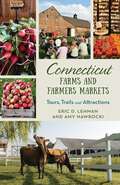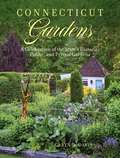- Table View
- List View
Conejo Valley
by Jeffrey Wayne MaulhardtThe amorphous Conejo Valley today encompasses the southeastern portion of Ventura County in and around Thousand Oaks, including Newbury Park and Lake Sherwood, near where the I-101 exits Los Angeles County at Westlake Village on its way west and north. Human history in the Conejo Valley dates back to the hunting and gathering days of the Chumash Native Americans. The short Spanish and Mexican periods added a few adobe buildings, erected for respites taken by vaqueros and later cattle rustlers on these rolling grasslands north of the coastal Santa Monica Mountains. In the 19th century, a grand hotel was constructed, and a stage route was established. Grain farmers tried to tame the thirsty hills of the Conejo Valley before the arrival of scenic neighborhoods and malls after World War II.
Conesus Lake (Images of America)
by Sharon L. MistrettaConesus Lake is the westernmost of the 11 Finger Lakes. Often referred to as one of the "Little Fingers," it is located about 25 miles south of Rochester, New York. In 1924, the City of Rochester announced plans to use Conesus Lake to supplement the water supply for its residents. A year later, cottagers around the lake successfully banded together to protect Conesus's sparkling waters and preserve the area as a summer resort. Over time, the lake area has grown, and restaurants, taverns, campgrounds, and amusement parks have sprung up from the demand of the lake's many visitors. Today, four towns--Geneseo, Groveland, Conesus, and Livonia--border the approximate 18 miles of shoreline.
Coney Island
by Laura J. HoffmanConey Island is famous for so much more than just hot dogs and wild rides. At the turn of the 20th century, it was known as the "Playground of the World." In the beginning, this upscale resort area catered to the rich. Between 1897 and 1904, three lavish amusements parks opened in Coney Island. By 1920, the subway extended to Stillwell Avenue, which made Coney Island more accessible for everyone. The abundant history is remarkable, and its peaks and valleys closely resemble one of its most famous icons, the roller coaster. Coney Island hit its apex between 1910 and 1930. Afterwards, it suffered through the Great Depression, went into major decline after World War II, and hit bottom in the 1970s and 1980s. In recent years, there has been a profound revitalization effort to bring the area back to its glory days. Despite the major setback caused by Superstorm Sandy in 2012, the spirit of Coney Island is alive and well.
Coney Island's Wonder Wheel Park (Images of America)
by Charles DensonThe venerable Wonder Wheel, Coney Island's oldest and greatest attraction, has dominated the Coney Island skyline for more than a century. Towering over an ephemeral amusement zone long plagued by fires, floods, and ill-conceived urban renewal schemes, the magnificent steel machine has proved to be the ultimate survivor. The ride boasts impressive statistics. A combination of roller coaster and Ferris wheel, the 150-foot-tall structure weighs 200 tons, has 16 swinging cars and 8 stationary cars, and can carry 144 riders. More than 40 million passengers have taken a ride on the wheel since it was built in 1920, and during that time, it has maintained a perfect safety record. The ride is also a monument to immigrant initiative. Charles Hermann, the ride's designer, was Romanian; the original owner, Herman Garms, was German; and Denos Vourderis, who purchased and lovingly restored the aging landmark in 1983, was Greek. An official New York City landmark, the Wonder Wheel is now owned and operated by three generations of the Vourderis family as the centerpiece of their Deno's Wonder Wheel Park. The enduring saga of this iconic ride, and the family that saved it, provide a captivating chapter of Coney Island's history.
Confederates Don't Wear Couture: A Tale Of Heartache, Haunting, And Hoop Skirts.
by Stephanie Kate StrohmPublishers Weekly praised the Pilgrims Don'tWear Pink author Stephanie Kate Strohm for "turning a strong heroine and a few surprises into a clever, tightly written book that will keep readers wondering who will become Libby's Mr. Darcy." This romantic sequel follows suit in high style! High-style hoopskirts, that is . . .When history nerd Libby's gay fashion designer best friend asks for help selling his gowns to the wives of Civil War reenactors, she jumps at the chance to frolick on a nineteenth-century playground. But Alabama's no sweet home: sweltering heat, no Starbucks, a vengeful ghost . . .And the boys? Miss Libby's got the North and the South fighting for her heart.
Confederates in the Attic: Dispatches from the Unfinished Civil War (Vintage Departures)
by Tony HorwitzNational Bestseller. When prize-winning war correspondent Tony Horwitz leaves the battlefields of Bosnia and the Middle East for a peaceful corner of the Blue Ridge Mountains, he thinks he's put war zones behind him. But awakened one morning by the crackle of musket fire, Horwitz starts filing front-line dispatches again this time from a war close to home, and to his own heart. Propelled by his boyhood passion for the Civil War, Horwitz embarks on a search for places and people still held in thrall by America's greatest conflict. The result is an adventure into the soul of the unvanquished South, where the ghosts of the Lost Cause are resurrected through ritual and remembrance. In Virginia, Horwitz joins a band of 'hardcore' re-enactors who crash-diet to achieve the hollow-eyed look of starved Confederates; in Kentucky, he witnesses Klan rallies and calls for race war sparked by the killing of a white man who brandishes a rebel flag; at Andersonville, he finds that the prison's commander, executed as a war criminal, is now exalted as a martyr and hero; and in the book's climax, Horwitz takes a marathon trek from Antietam to Gettysburg to Appomattox in the company of Robert Lee Hodge, an eccentric pilgrim who dubs their odyssey the 'Civil Wargasm.' Written with Horwitz's signature blend of humor, history, and hard-nosed journalism, Confederates in the Attic brings alive old battlefields and new ones 'classrooms, courts, country bars' where the past and the present collide, often in explosive ways. Poignant and picaresque, haunting and hilarious, it speaks to anyone who has ever felt drawn to the mythic South and to the dark romance of the Civil War.
Confederates in the Tropics: Charles Swett's Travelogue
by Frederick Stirton Weaver Sharon Hartman StromCharles Swett (1828–1910) was a prosperous Vicksburg merchant and small plantation owner who was reluctantly drawn into secession but then rallied behind the Confederate cause, serving with distinction in the Confederate Army. After the war some of Swett’s peers from Mississippi and other southern states invited him to explore the possibility of settling in British Honduras or the Republic of Honduras. Confederates in the Tropics uses Swett’s 1868 travelogue to explore the motives of would-be Confederate migrants fleeing defeat and Reconstruction in the United States South. The authors make a comparative analysis of Confederate communities in Latin America and use Charles Swett’s life to illustrate the travails and hopes of the period for both Black and white people. Swett’s diary is presented here in its entirety in a clear, accessible format, edited for contemporary readers. Swett’s style, except for his passionate prefatory remarks, is a remarkably unsentimental, even scientific look at Belize and Honduras, more akin to a field report than a romantic travel account. In a final section, the authors suggest why the expatriate communities of white Southerners nearly always failed, and they follow up on Swett’s life in Mississippi in a way that sheds light on why disgruntled Confederates decided to remain in or eventually to return to the US South.
Conferences and Conventions 3rd edition: A Global Industry (Events Management)
by Tony RogersConferences and Conventions: A Global Industry 3rd edition provides a comprehensive introduction to the key elements of the global conference, convention and meetings industry. It examines the industry’s origins, structure, economic, social and environmental impacts, education, training and career opportunities, and the industry's future development. It also explores its links with the wider tourism industry, and suggests that there should be a realignment of these links, putting a greater focus on designing, executing and measuring meeting and convention contents so that they have a purposeful impact on participants, thus creating greater value for stakeholders. It suggests that there should be greater emphasis on the role that meetings play in economic, professional and educational development, promoting the benefits they provide in knowledge exchange, scientific research, technology transfer, networking and motivation and showing clearly what such business events actually accomplish. This revised 3rd edition has been updated to reflect current trends and emerging topics and achieve a more international approach. This edition has also been updated with the following features: New content on social media, web based marketing, the use of technology, experiential marketing and events, the role of trade shows in conventions,?issues of sustainability, and moves to create a profession for event management. Fully integrated and updated case studies to highlight current issues and demonstrate theory in practice. Also contains new case studies on the growth markets of Asia, Brazil and the Middle East. A detailed meetings and events industry lexicon. This book is written in an accessible and engaging style and structured logically with useful features throughout to aid students’ learning and understanding. This book is an invaluable resource to students following Events Management, Hospitality and Tourism courses. ?
Conferences and Conventions: A Global Industry (Events Management)
by Tony Rogers Peter Wynn-MoylanFully revised and updated to reflect current trends and emerging topics, the fourth edition of Conferences and Conventions: A Global Industry provides an expert-led, comprehensive introduction to, and overview of, the key elements of the global conference, convention and meetings industry. This book examines the conference industry’s origins, structure and future development, as well as its economic, social and environmental impacts. It provides an in-depth analysis of the strategies, practices, knowledge and skills required to organise memorable conferences and similar business events, with detailed descriptions of all the planning and operational processes. Following an international approach, this edition features additional sections on the increase in technological advancements and opportunities, as well as the rise of virtual and hybrid events in a post-pandemic era. Written in an accessible and engaging style, the book includes integrated case studies to highlight current issues and demonstrate theory in practice. Structured logically with useful features throughout to aid learning and understanding, this book is an invaluable resource to students following events management, hospitality and tourism courses, as well as for event planners and practitioners already working in the conference industry.
Conferences and Conventions: A Research Perspective (Routledge Advances in Event Research Series)
by Judith MairConferences and conventions are one of the fastest growing areas of the events industry. This is a substantially important sector yet research into many dimensions is in its infancy. This timely book, uniquely presents a ‘state of the art’ synthesis of the research on both demand and supply sides of the industry as well as insights into how current and future trends are affecting conferences and conventions. This volume provides a critical review of the players involved in conferences and conventions; destination image and impacts; and current and future trends. The players in the industry include attendees/delegates, professional conference organisers, and association meeting planners. On the destination side, conference venues and facilities, along with convention and visitor bureaux are examined, as well as how destination image can be developed and improved. Further, this section considers the economic, social and environmental impacts of conferences and conventions. The final section considers some of the major trends that are likely to impact on the industry, including climate change, new technologies and risk and crisis management. To reflect the sector’s international nature case studies and examples from different geographical regions are included throughout. By identifying gaps in our knowledge, and presenting a collection of themes to guide future research, this book not only adds to our current knowledge, but will underpin the advancement of knowledge in the future. This book is essential reading for all those interested in Events.
Confessions from Correspondentland: The Dangers and Delights of Life as a Foreign Correspondent
by Nick BryantSince making his journalistic debut breaking into Piers Morgan's office, BBC foreign correspondent Nick Bryant has rattled Donald Rumsfeld, had tea with President Karzai, slept through 9/11, and gotten a free lunch out of the Tamil Tigers. Now casting a sideways glance at his own profession, Nick reveals the day-to-day realities of 'Correspondentland' - its glamour, its quirks, and its sometimes unsavoury practices. Learn how to evade a shoot-to-kill curfew, the media's 'rulebook' for natural disasters, and when fireproof underwear is an absolute essential.Nick Bryant is currently New York correspondent for the BBC and was formerly the BBC's Washington correspondent. He provides a window onto American politics that no insider can. From how Bush saves seats for his favorite reporters to how Clinton responds to questions about that little blue dress, Bryant discovers the dangers and delights of seeing the world through this unique and often strange perspective.Part memoir, part travelogue, part exposé, this is an unmissable insight into the world of modern reporting, and an intimate portrait of the countries Nick has come to know.
Confessions of a Traveloholic: To Travel Is To Evolve
by Ashish Raisinghani"Confessions of a Traveloholic" by Col. Ashish Raisinghani offers a captivating insight into the world of travel through the eyes of an experienced Indian Army Officer. Spanning over two decades of exploration, Raisinghani shares thirteen compelling travelogues, ranging from solo backpacking adventures to heartwarming family trips with his wife and daughter. With a keen eye for detail and a philosophical approach, Raisinghani delves into the essence of travel, distinguishing between mere tourists and true travelers who seek immersive experiences and continuous growth. Through vivid storytelling and practical insights, this book inspires readers to embark on their own journeys of self-discovery, embracing the joy of exploration and the transformative power of travel.
Confessions of an Event Planner: Case Studies from the Real World of Events--How to Handle the Unexpected and How to Be a Master of Discretion
by Judy AllenFor anyone planning events—student, novice, or experienced professional—Confessions of an Event Planner is an “apprenticeship in a book.” This insider’s guide takes you on a narrative journey, following a fictional event planning company that stages various types of events around the world for many different clients. While other books, college courses, and training programs give you the theory and how-to of the profession, Confessions of an Event Planner reveals the real world of event planning and what can happen—usually the unexpected—on an event program when actual participants are added to the event planning design and execution mix. In a climate of media scrutiny and corporate scandals, event planners must be masters of discretion, knowing how to avoid and deal with everything from sexual romps to financial shenanigans, to chainsaw wielding salesmen dead set on “re-landscaping” the grounds of the resort they’re staying at. From an event planner who’s seen it all and knows how to deal with it all, comes practical first-hand advice delivered in an entertaining and accessible format. Each chapter is set in a unique location, with a cast of characters, and a host of challenges and problems to overcome—from the boardroom to the resort guest bedrooms. Readers learn what they can come up against, how to problem solve creatively on the fly, get ideas for staging spectacular events, and see the principles of event planning in action. The scenario in each chapter is introduced by an outline of what will be covered in the chapter, and each chapter concludes with a series of review questions to explore key issues and stimulate reflection or discussion for individuals or groups. Ideal as a companion to Judy Allen’s six other event planning books, as a textbook in event planning courses, or as a professional training tool Confessions of an Event Planner prepares planners for what they can expect once they start working in the world of corporate and social event planning, and will help decision-makers set company policies, procedures and protocol and promote discussion about codes of conduct in the office and offsite.
Confines: Navegando aguas árticas y antárticas
by Javier ReverteTras el éxito de En mares salvajes, Javier Reverte vuelve al frío con su pluma cálida y cargada de humor. ¿Adónde ir cuándo se ha pateado tanto mundo como Javier Reverte? Como él mismo dice, el planeta se hace mucho más grande conforme vas conociéndolo mejor y siempre hay nuevos paisajes que se abren al sueño y a la vocación de conocer. Por eso ha escogido como destino en esta ocasión los extremos boreal y austral del globo: dos navegaciones por los mares árticos y antárticos, realizadas con pocos meses de diferencia, que constituyen la entraña de este nuevo libro viajero. Una primavera polar transcurre a bordo de un barco de investigación noruego, se adentra en las islas árticas de Svalbard y continúa hacia el norte, en latitudes ya muy próximas al Polo Norte. En su relato, no solo nos habla de las peripecias de la navegación, sino de las exploraciones en busca del extremo septentrional del planeta, de los efectos del cambio climático, del calentamiento global y de las amenazas que penden, por causa de todo ello, sobre la humanidad. Octubre en el Cabo de Hornos recorre los canales, islas, estrechos, penínsulas, cordilleras y mares recoletos de Tierra de Fuego, y llega a la isla del Cabo de Hornos. Nos habla de los viajes de Magallanes, Raleigh, Fitz-Roy, Darwin y otros exploradores, y de Ushuaia, la ciudad del fin del mundo, y de su famoso penal. «Para mí, el hecho de viajar es lo que importa, y el cómo se lleve a cabo el viaje no me parece lo sustancial. La cuestión es moverse, irse, largarse del propio terruño con los sentidos abiertos, expuesto a dejarse cautivar por todo cuanto hay de novedoso en los caminos del mundo, lo mismo si son sendas de tierra que si han sido trazados, invisibles, sobre el agua o sobre el viento. En grupo o en solitario, en avión o en autocar, de día o de noche, por unas cuantas jornadas o por una larga temporada, rumbo al sur o rumbo al norte, hacia el este o el oeste, pernoctando en hoteles de lujo o en cabañas mugrientas... lo esencial es moverse, ya digo, "con el camino bajo los pies y el cielo sobre la cabeza", como pedía Stevenson. Solo así aprendemos a mirarnos en los espejos del mundo.»Javier Reverte
Conflict and Hostility in Hotels, Restaurants, and Bars
by Conrad LashleyThis book critically explores conflict and hostility in a range of hospitality settings and from a broad stakeholder perspective.The provision of accommodation, food, and drink in commercial settings has conflict at its core because the commercial transaction between hosts and guests can result in a clash of expectations between the server and served. These service encounters involve stakeholders other than immediate personnel and their clients; owners, managers, local communities, and regulatory and licensing authorities also have concerns about the hotels, restaurants, and bars in their midst. The book recognises that these different stakeholders frequently have common interests but are also in conflict as their needs and goals compete with others. By reviewing these multi-agenda perspectives, the contributors offer new insights into topics such as conflict theory within the hospitality industry, human trafficking, employee conflict, dysfunctional leadership, tall poppy syndrome, and the impacts of over-tourism on host communities.Written by leading international academics, this significant volume will be of interest to students, researchers, and academics interested in critical hospitality studies, sociology, and business, as well as anthropology and culture studies.
Conflicts, Religion and Culture in Tourism
by Razaq Raj Kevin A. GriffinConflicts, Religion and Culture in Tourism highlights the role of religious tourism and pilgrimage as a tool for improving cultural relations. Helping to form culture and society worldwide, faith plays a vital part in cross-cultural conflict resolution and opening dialogue across peoples. This book shows how faith and activism can respond to the common challenges of peace making and coexistence both within and among the world's many traditions. The book: - contains diverse empirical research insights on aspects of religious traditions, conflicts and challenges; - presents a range of contemporary case studies, across ancient, sacred and emerging tourist destinations as well as new forms of pilgrimage, faith systems and quasi-religious activities; - provides a global perspective, including contributions from Europe, Asia and the Americas. Conflicts, Religion and Culture in Tourism provides a timely assessment of the increasing linkages and interconnections between religious tourism and secular spaces on a global stage. Written from a multidisciplinary perspective, it provides an invaluable resource for those studying and researching religion, tourism and cultural management.
Conflicts, Religion and Culture in Tourism (CABI Religious Tourism and Pilgrimage Series)
by Yasin Bilim Professor Maximiliano Korstanje Ayesha Chowdhury Maite Echarri-Chavez Necmeddin Guney Tinka Delakorda Kawashima Katerina Kikilia Lourdes Cisneros Mustellier Dimitrios Mylonopoulos Moira Polyxeni Özgür Özer Balal Qayum Jan Rája Manas Ranjan Sanjeev Singh Kartikeya Sonker Rukeya Suleman Panagiota Vasilopoulou Pierre WiktorinConflicts, Religion and Culture in Tourism highlights the role of religious tourism and pilgrimage as a tool for improving cultural relations. Helping to form culture and society worldwide, faith plays a vital part in cross-cultural conflict resolution and opening dialogue across peoples. This book shows how faith and activism can respond to the common challenges of peace making and coexistence both within and among the world's many traditions. The book: - contains diverse empirical research insights on aspects of religious traditions, conflicts and challenges; - presents a range of contemporary case studies, across ancient, sacred and emerging tourist destinations as well as new forms of pilgrimage, faith systems and quasi-religious activities; - provides a global perspective, including contributions from Europe, Asia and the Americas. Conflicts, Religion and Culture in Tourism provides a timely assessment of the increasing linkages and interconnections between religious tourism and secular spaces on a global stage. Written from a multidisciplinary perspective, it provides an invaluable resource for those studying and researching religion, tourism and cultural management.
Confluence: A River, The Environment, Politics, & The Fate of All Humanity
by Nathaniel TrippAmidst the global free market economy, the author warns us against the politicization of various issues and wants us to look at the larger issues like global warming.
Congaree National Park (Images of Modern America)
by John E. CelyLocated in central South Carolina, only a few miles from the capital city of Columbia, Congaree National Park is the largest old-growth bottomland hardwood forest left in the country and one of the most biologically diverse parks within the national park system. Nearly 100 species of trees have been documented within the park, almost as many as in the entire Pacific Northwest. The park has one of the tallest hardwood forests anywhere in the temperate world and features numerous trees of record-setting proportions, a distinction that has earned it the name �Forest of Champions.� This book discusses the early history of the area that later became the Congaree National Park, shows efforts to protect it from logging by a citizen�s grassroots campaign, traces the park�s early beginnings and development, and illustrates some of the park�s notable flora and fauna.
Congo Solo: Misadventures Two Degrees North
by Emily HahnA woman who lived life on her own terms, Hahn was an unknown and struggling writer when Congo Solo was published. Here - restored to the form she had intended - is Hahn's unforgettable narrative, a vivid, provocative, and at times disturbing first-hand account of the racism, brutality, sexism, and exploitation that were everyday life realities under Belgium's iron-fisted colonial rule. Until now, the few copies of Congo Solo in circulation were the adulterated version, which the author altered after pressure from her publisher and threats of litigation from the main character's family. This edition makes available a lost treasure of women's travel writing that shocks and impresses, while shedding valuable light on the gender and race politics of the period.
Conneaut Lake Park
by Michael E. CostelloIn 1877, a humble boat landing was constucted on Conneaut Lake, Pennsylvania's largest natural lake. Colonel Frank Mantor, a visionary, discovered and purchased the property and convinced investors from the Pittsburgh, Shenango, and Lake Erie Railroad to extend the railroad line to a newly built resort on the site. In 1892, Exposition Park--a permanent fair exhibiting machinery and livestock--was founded. Amusement rides wereadded alongside hotels, cottages, restaurants, and other businesses. The resort grew into an amusement park and was renamed Conneaut Lake Park in 1920. Conneaut Lake Park illustrates the evolution of this lakeside resort with images of long-gone attractions such as the Hotel Elmwood, Temple of Music, Jungle Cruise, Fairyland Forest, and Wild Mouse. Recent favorites such as the Blue Streak, Tumble Bug, Ultimate Trip, and Devil's Den are also included.
Connecticut Beer: A History of Nutmeg State Brewing (American Palate)
by Will Siss Ron PageThe history of the frothy beverage in Connecticut dates back to early colonists, who used it to quench their thirst in the absence of clean drinking water. So integral was beer to daily life in the colony that government officials and militiamen congregated in taverns like the General Wolfe to talk laws and business over pints of ale. Over the next two centuries, the number of breweries rose and then declined, especially after Prohibition. It was not until the 1980s that homebrewers brought this vital Nutmeg State tradition back to life, hatching the likes of New England and Cottrell Brewing Companies, as well as brewpubs including City Steam and Southport Brewing. More recently, small operations with one or two people, such as Relic and Beer'd, are changing the landscape again. Connecticut beer writer Will Siss introduces readers to the hardworking people who keep the breweries and beer bars inviting and the hoppy history alive.
Connecticut Curiosities: Quirky Characters, Roadside Oddities & Other Offbe (Curiosities Series)
by Ray Bendici Susan Campbell Bill HealdConnecticut Curiosities, 3rd Edition is part of a GPP homegrown series of state-specific books that describe, with humor and affection—and a healthy dose of attitude—the oddest, quirkiest, and most outlandish places, personalities, events, and phenomena found within the state&’s borders and in the chronicles of its history.A fun, accessible read for travelers and non travelers alike—a great armchair book with quirky b/w photographs throughout and maps for each region. They can be thought of as combination almanacs, off-the-wall travel guides, and wacky news gazettes, all with a decidedly humorous twist.The narrative is good-naturedly humorous. Connecticut Curiosities, 3rd Edition is filled with humorous state facts and amusing stories and sports a visually varied, browsable design (with sidebars, archival photos, etc.). Part zany Connecticut guidebook and part Who's Who of odd and unsung heroes, this compendium of the state's quirks and characters will amuse Connecticut residents and visitors alike.
Connecticut Farms and Farmers Markets: Tours, Trails and Attractions (Farms and Farmers Markets)
by Eric D. Lehman Amy NawrockiFrom Salisbury to Stonington and everywhere in-between, Connecticut farms are calling you. Whether you are searching for the most authentic agricultural experiences or for the most sustainable option for the planet, whether you want to support the local economy or improve your personal connections, this book profiles the farms and farmers that will help you in your quest. Inside, you will find agritourism opportunities like local markets, festivals, pick-your-owns, museums, tree farms, fairs, and much more. You can sip wine at a hilltop farm winery or tap maple trees deep in a forest or ride with llamas on a pleasant trail. You can pick apples, shuck oysters, or just enjoy a gallon of freshly made ice cream. With this guide you will improve your relationship with the land, with your agricultural neighbors, and with your home.
Connecticut Gardens: A Celebration of the State's Historic, Public, and Private Gardens
by Caryn B. Davis&“The glorious photographs by Caryn B. Davis dispel the adage that you must stand in the space of any garden to fully appreciate it. Each garden is carefully described and brought to life on the page in the most perfect light, at the peak of bloom and in vivid color—a joy to experience.&” —BARBARA PAUL ROBINSON, Honorary Director of Wave Hill and a Director Emerita of The Garden Conservancy &“Caryn B. Davis&’s third photographic masterpiece has captured each garden as one would see it in person. Having covered the state as a reporter since 1987 for WTNH-TV, I can assure you this book has captured its widespread beauty. We all benefi t from her magnifi cent eye.&” —ANN NYBERG, Anchor/Reporter, WTNH-TV Connecticut Gardens: A Celebration of the State&’s Historic, Public, and Private Gardens takes readers on a visual tour of some of the state&’s most breathtaking historic, public, and private gardens. From simple cottage gardens to stunning botanical achievements and sumptuous formal landscapes, this book introduces readers to the glorious gardens created by passionate amateurs, professional designers, and notable luminaries such as Frederick Law Olmsted, Gertrude Jekyll, and Beatrix Farrand. Hear their stories, discover the history and inspiration behind their designs,and learn the benefits of having public gardens. With lush photography and entertaining yet informative text, Connecticut Gardens is a delight to the senses and serves as a useful guide for discovering new gardens to behold.





